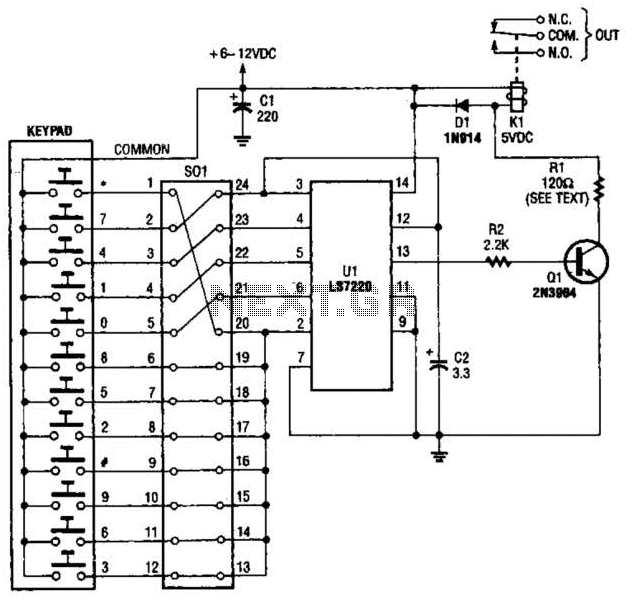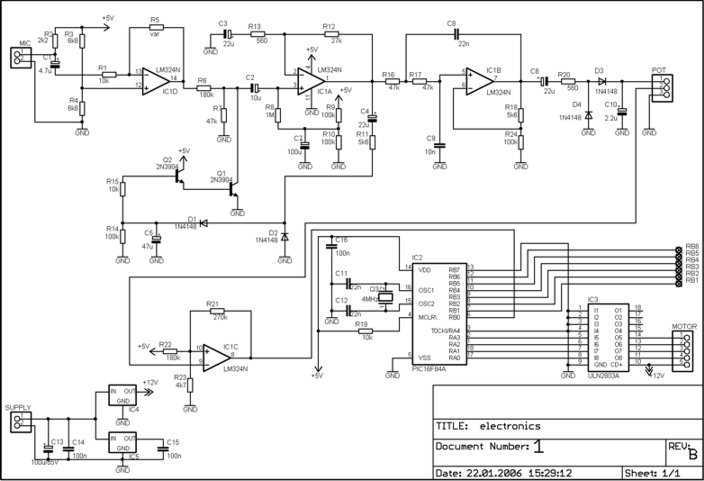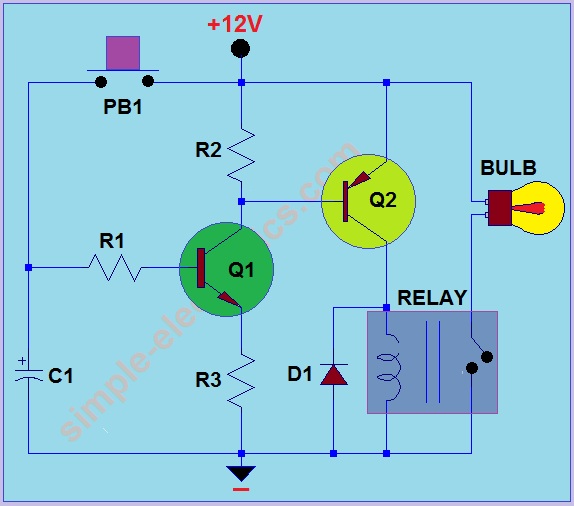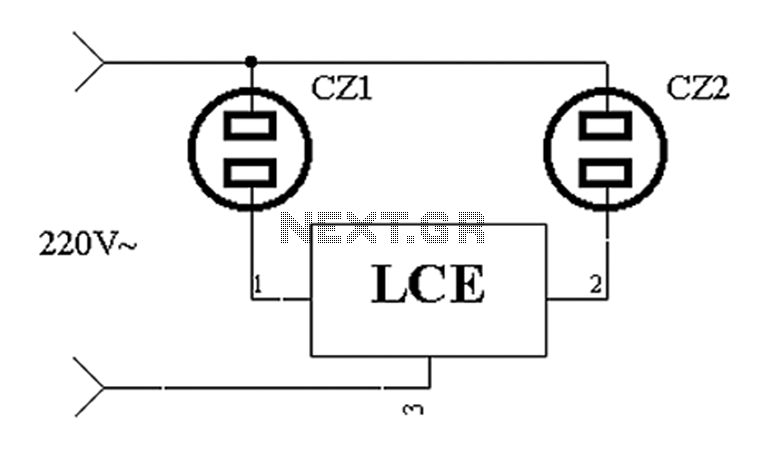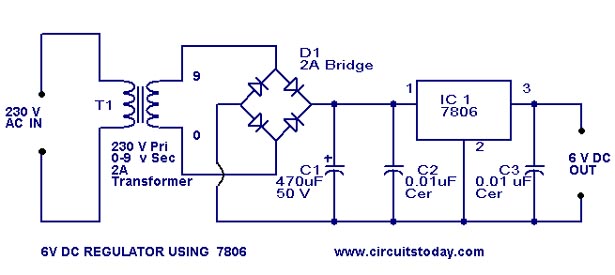
Light touch variable delay circuit

The circuit operates without a base current for the transistor. It turns off when the metal sheet is touched, causing the capacitor to start charging. The capacitor charges to 2V over a specified time. The circuit generates a conduction state in a silicon SCR when triggered by a DC voltage. It consists of ten components. The circuit discharges continuously, and the lights turn off when a specific metal contact is made. Touching the metal briefly alters the voltage across the circuit, affecting the discharge time. A longer touch results in a higher charging voltage and a longer delay before the lights turn off.
The circuit described utilizes a silicon controlled rectifier (SCR) to control the lighting based on touch input. The absence of a base current indicates that the circuit is designed to operate in a low-power state until activated. When the metal sheet is touched, it triggers a change in the state of the circuit, allowing the capacitor to charge. The charging process is time-dependent, with the capacitor reaching a voltage of 2V.
The SCR is a key component that allows for the conduction of current when triggered by a direct current (DC) voltage. The circuit's design incorporates ten essential components, which may include resistors, capacitors, diodes, and the SCR itself. The continuous discharge of the circuit is a critical feature, as it ensures that the lights remain off when the metal contact is established.
The interaction between the touch input and the circuit's voltage dynamics is significant. A brief touch increases the voltage across the circuit, leading to a shorter duration of light activation. Conversely, a prolonged touch results in a higher charging voltage, which extends the delay before the lights turn off. For instance, a one-second touch can produce a charging voltage of 5V with a delay of 100 seconds, while a two-second touch yields a charging voltage of 7.5V and a delay of 140 seconds. A three-second touch increases the charging voltage further to 10V, with a 15-second delay before the lights extinguish.
This behavior exemplifies the circuit's sensitivity to touch duration, allowing for a customizable lighting experience based on user interaction. The theoretical calculations supporting this design provide insight into the expected performance and operational parameters, ensuring reliability and efficiency in its application.vl.U no mantle base current. Open cut II:, n is also turned off when the touch when the metal sheet. CI JF start charging. Lu Ci Bu l: charge to 2V Tsui l: time. V, Chong: im, generating Rs L DC dirty drop trigger pull bite silicon SCR conduction, the lights. It consists of ten C. The more people who ask constant discharge, open extension l column Duan Yan lights off when M. When you touch the metal "M I little while when the voltage across the electrical .q TV Division, touch steamed shabu li inch shorter, lower C, both ends of the voltage discharge M also girl, so electric lights time is short, and vice versa r cancer when I change may K. So Shing touch setback time delay n.rriil_ boots close by varying widely cited theoretical calculation, when touch hug one second, ' a charging voltage of 5v, delay IOO seconds; 2 seconds touch Ut, CI charging voltage is 7.5v.
delay l40 seconds, 3 seconds break contact resistance, cl charging voltage IOV. la5 seconds delay.
The circuit described utilizes a silicon controlled rectifier (SCR) to control the lighting based on touch input. The absence of a base current indicates that the circuit is designed to operate in a low-power state until activated. When the metal sheet is touched, it triggers a change in the state of the circuit, allowing the capacitor to charge. The charging process is time-dependent, with the capacitor reaching a voltage of 2V.
The SCR is a key component that allows for the conduction of current when triggered by a direct current (DC) voltage. The circuit's design incorporates ten essential components, which may include resistors, capacitors, diodes, and the SCR itself. The continuous discharge of the circuit is a critical feature, as it ensures that the lights remain off when the metal contact is established.
The interaction between the touch input and the circuit's voltage dynamics is significant. A brief touch increases the voltage across the circuit, leading to a shorter duration of light activation. Conversely, a prolonged touch results in a higher charging voltage, which extends the delay before the lights turn off. For instance, a one-second touch can produce a charging voltage of 5V with a delay of 100 seconds, while a two-second touch yields a charging voltage of 7.5V and a delay of 140 seconds. A three-second touch increases the charging voltage further to 10V, with a 15-second delay before the lights extinguish.
This behavior exemplifies the circuit's sensitivity to touch duration, allowing for a customizable lighting experience based on user interaction. The theoretical calculations supporting this design provide insight into the expected performance and operational parameters, ensuring reliability and efficiency in its application.vl.U no mantle base current. Open cut II:, n is also turned off when the touch when the metal sheet. CI JF start charging. Lu Ci Bu l: charge to 2V Tsui l: time. V, Chong: im, generating Rs L DC dirty drop trigger pull bite silicon SCR conduction, the lights. It consists of ten C. The more people who ask constant discharge, open extension l column Duan Yan lights off when M. When you touch the metal "M I little while when the voltage across the electrical .q TV Division, touch steamed shabu li inch shorter, lower C, both ends of the voltage discharge M also girl, so electric lights time is short, and vice versa r cancer when I change may K. So Shing touch setback time delay n.rriil_ boots close by varying widely cited theoretical calculation, when touch hug one second, ' a charging voltage of 5v, delay IOO seconds; 2 seconds touch Ut, CI charging voltage is 7.5v.
delay l40 seconds, 3 seconds break contact resistance, cl charging voltage IOV. la5 seconds delay.
